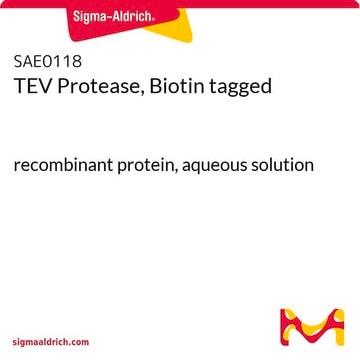SAE0110
HRV-3C Protease, Biotin tagged
Recombinant protein, 0.8-1.2 mg/mL, aqueous solution
Synonyme(s) :
Human Rhinovirus 3C Protease, Levlfqgp site protease, PreScission Protease
Sélectionner une taille de conditionnement
333,00 $
Sélectionner une taille de conditionnement
About This Item
333,00 $
Produits recommandés
Source biologique
human (human Rhinovirus Type 14)
Produit recombinant
expressed in E. coli
Essai
≥90%
Forme
aqueous solution
Activité spécifique
≥5000 U/mg
Poids mol.
22 kDa
Concentration
0.8-1.2 mg/mL
Technique(s)
protein purification: suitable
Adéquation
suitable for protein modification
Application(s)
life science and biopharma
Conditions d'expédition
dry ice
Température de stockage
−20°C
Description générale
This biotinylated HRV-3C protease is intended for on-column cleavage of fusion proteins with an HRV-3C cleavage site. It specifically cleaves the protein of interest from a column-bound fusion protein, leaving the fusion domain or tag bound to the affinity column (e.g. Ni-NTA column) and eluting only the protein of interest. This method is advantageous over post-elution cleavage for several reasons:
- It eliminates most impurities normally associated with purification on Ni-chelating columns.
- It allows gentler elution conditions, with added flexibility in the elution buffer composition. This can mitigate protein aggregation and inactivation.
After cleavage, the protease can be removed with any avidin-conjugated or streptavidin-conjugated beads. This product has been enzymatically biotinylated with no effect on its proteolytic activity. It has no additional protein purification tags. The product is supplied in aqueous buffer (0.8–1.2 mg/mL) with 20 mM Trizma®-HCl, pH 8.0, 200 mM NaCl, 1 mM TCEP, and 50% (v/v) glycerol.
Notes préparatoires
Informations légales
Code de la classe de stockage
10 - Combustible liquids
Classe de danger pour l'eau (WGK)
WGK 2
Point d'éclair (°F)
Not applicable
Point d'éclair (°C)
Not applicable
Faites votre choix parmi les versions les plus récentes :
Certificats d'analyse (COA)
Vous ne trouvez pas la bonne version ?
Si vous avez besoin d'une version particulière, vous pouvez rechercher un certificat spécifique par le numéro de lot.
Déjà en possession de ce produit ?
Retrouvez la documentation relative aux produits que vous avez récemment achetés dans la Bibliothèque de documents.
Articles
Proteases for biotinylated tag removal for protein purification workflows with related reagents and technical resources.
Active Filters
Notre équipe de scientifiques dispose d'une expérience dans tous les secteurs de la recherche, notamment en sciences de la vie, science des matériaux, synthèse chimique, chromatographie, analyse et dans de nombreux autres domaines..
Contacter notre Service technique








